Yongzhao Li
Power Control and Random Serving Mode Allocation for CJT-NCJT Hybrid Mode Enabled Cell-Free Massive MIMO With Limited Fronthauls
Sep 03, 2024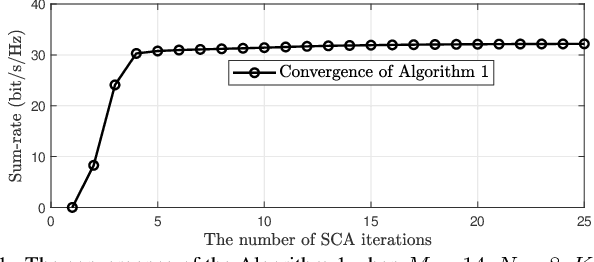
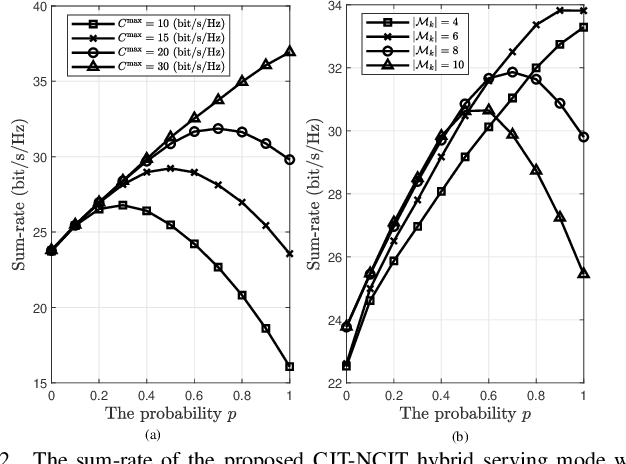
Abstract:With a great potential of improving the service fairness and quality for user equipments (UEs), cell-free massive multiple-input multiple-output (mMIMO) has been regarded as an emerging candidate for 6G network architectures. Under ideal assumptions, the coherent joint transmission (CJT) serving mode has been considered as an optimal option for cell-free mMIMO systems, since it can achieve coherent cooperation gain among the access points. However, when considering the limited fronthaul constraint in practice, the non-coherent joint transmission (NCJT) serving mode is likely to outperform CJT, since the former requires much lower fronthaul resources. In other words, the performance excellence and worseness of single serving mode (CJT or NCJT) depends on the fronthaul capacity, and any single transmission mode cannot perfectly adapt the capacity limited fronthaul. To explore the performance potential of the cell-free mMIMO system with limited fronthauls by harnessing the merits of CJT and NCJT, we propose a CJT-NCJT hybrid serving mode framework, in which UEs are allocated to operate on CJT or NCJT serving mode. To improve the sum-rate of the system with low complexity, we first propose a probability-based random serving mode allocation scheme. With a given serving mode, a successive convex approximation-based power allocation algorithm is proposed to maximize the system's sum-rate. Simulation results demonstrate the superiority of the proposed scheme.
A Recursion-Based SNR Determination Method for Short Packet Transmission: Analysis and Applications
Aug 23, 2024



Abstract:The short packet transmission (SPT) has gained much attention in recent years. In SPT, the most significant characteristic is that the finite blocklength code (FBC) is adopted. With FBC, the signal-to-noise ratio (SNR) cannot be expressed as an explicit function with respect to the other transmission parameters. This raises the following two problems for the resource allocation in SPTs: (i) The exact value of the SNR is hard to determine, and (ii) The property of SNR w.r.t. the other parameters is hard to analyze, which hinders the efficient optimization of them. To simultaneously tackle these problems, we have developed a recursion method in our prior work. To emphasize the significance of this method, we further analyze the convergence rate of the recursion method and investigate the property of the recursion function in this paper. Specifically, we first analyze the convergence rate of the recursion method, which indicates it can determine the SNR with low complexity. Then, we analyze the property of the recursion function, which facilitates the optimization of the other parameters during the recursion. Finally, we also enumerate some applications for the recursion method. Simulation results indicate that the recursion method converges faster than the other SNR determination methods. Besides, the results also show that the recursion-based methods can almost achieve the optimal solution of the application cases.
QoE-based Semantic-Aware Resource Allocation for Multi-Task Networks
May 11, 2023Abstract:In semantic communications, only task-relevant information is transmitted, yielding significant performance gains over conventional communications. To satisfy user requirements for different tasks, we investigate the semantic-aware resource allocation in a multi-cell network for serving multiple tasks in this paper. First, semantic entropy is defined and quantified to measure the semantic information for different tasks. Then, we develop a novel quality-of-experience (QoE) model to formulate the semantic-aware resource allocation problem in terms of semantic compression, channel assignment, and transmit power allocation. To solve the formulated problem, we first decouple it into two subproblems. The first one is to optimize semantic compression with given channel assignment and power allocation results, which is solved by a developed deep Q-network (DQN) based method. The second one is to optimize the channel assignment and transmit power, which is modeled as a many-to-one matching game and solved by a proposed low-complexity matching algorithm. Simulation results validate the effectiveness and superiority of the proposed semantic-aware resource allocation method, as well as its compatibility with conventional and semantic communications.
QoE-Aware Resource Allocation for Semantic Communication Networks
May 28, 2022


Abstract:With the aim of accomplishing intelligence tasks, semantic communications transmit task-related information only, yielding significant performance gains over conventional communications. To guarantee user requirements for different types of tasks, we perform the semantic-aware resource allocation in a multi-cell multi-task network in this paper. Specifically, an approximate measure of semantic entropy is first developed to quantify the semantic information for different tasks, based on which a novel quality-of-experience (QoE) model is proposed. We formulate the QoE-aware semantic resource allocation in terms of the number of transmitted semantic symbols, channel assignment, and power allocation. To solve this problem, we first decouple it into two independent subproblems. The first one is to optimize the number of transmitted semantic symbols with given channel assignment and power allocation, which is solved by the exhaustive searching method. The second one is the channel assignment and power allocation subproblem, which is modeled as a many-to-one matching game and solved by the proposed low-complexity matching algorithm. Simulation results demonstrate the effectiveness and superiority of the proposed method on the overall QoE.
An Extended Kalman Filter for Distance Estimation and Power Control in Mobile Molecular Communication
May 19, 2022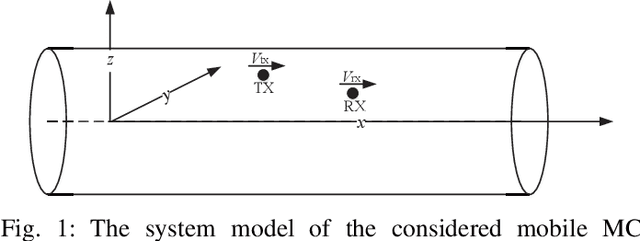
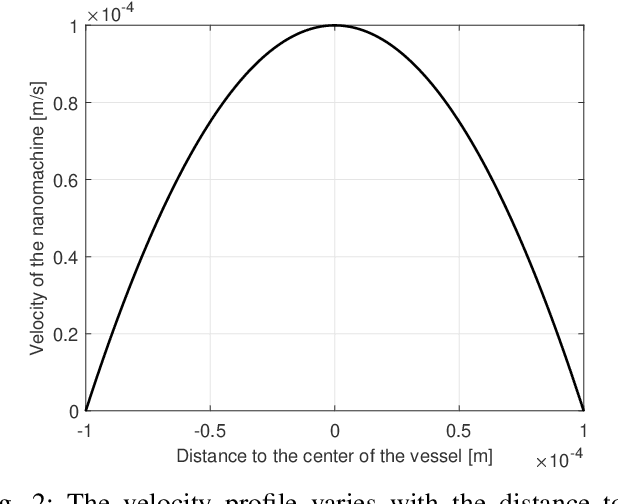
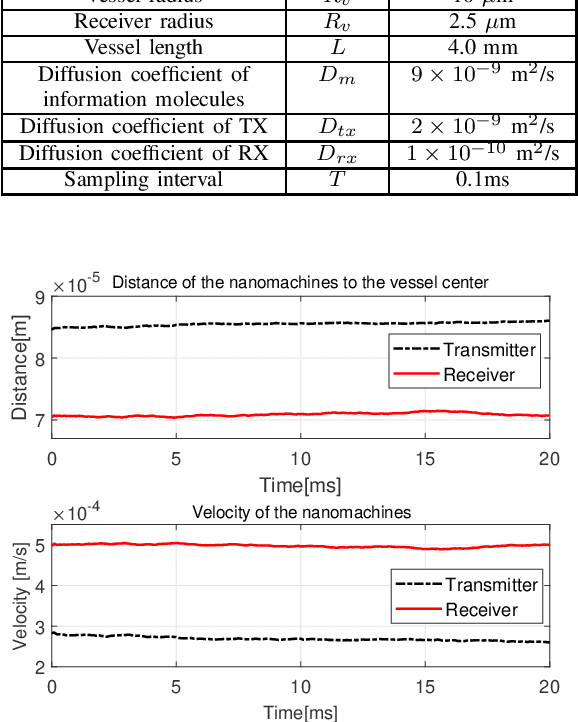
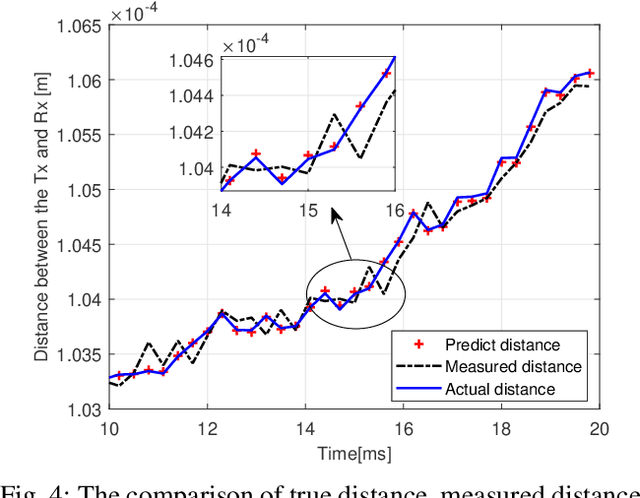
Abstract:In this paper, we consider a mobile molecular communication (MC) system consisting of two mobile nanomachines, a transmitter and a receiver, propelled by a positive drift velocity and Brownian motion in a realistic blood-vessel-type flow regime. Considering the nonlinear movement of the nanomachines, an extended Kalman filter is employed to estimate the distance from the transmitter. Furthermore, based on the predicted distance, to keep the number of received molecules for bit 1 at a stable level, we employ power control on the number of transmitted molecules based on the distance between the transmitter and the receiver and the residual molecules in the channel from the previous transmission. Finally, the optimal detection threshold is obtained by minimizing the error probability. It is verified that a fixed optimal detection threshold can be effective for the power control scheme in the mobile MC. The bit error rate (BER) performance of our scheme is verified via simulation results.
Resource allocation for semantic-aware networks
Jan 16, 2022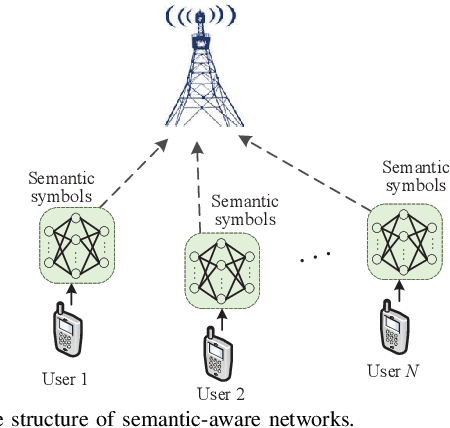
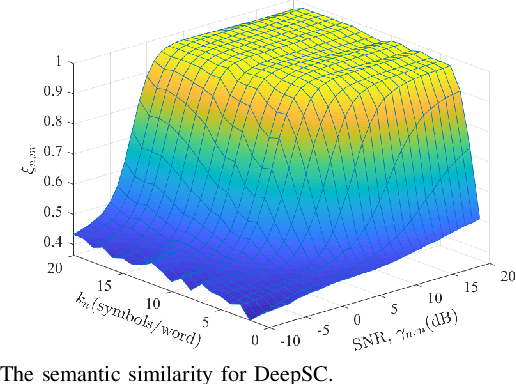

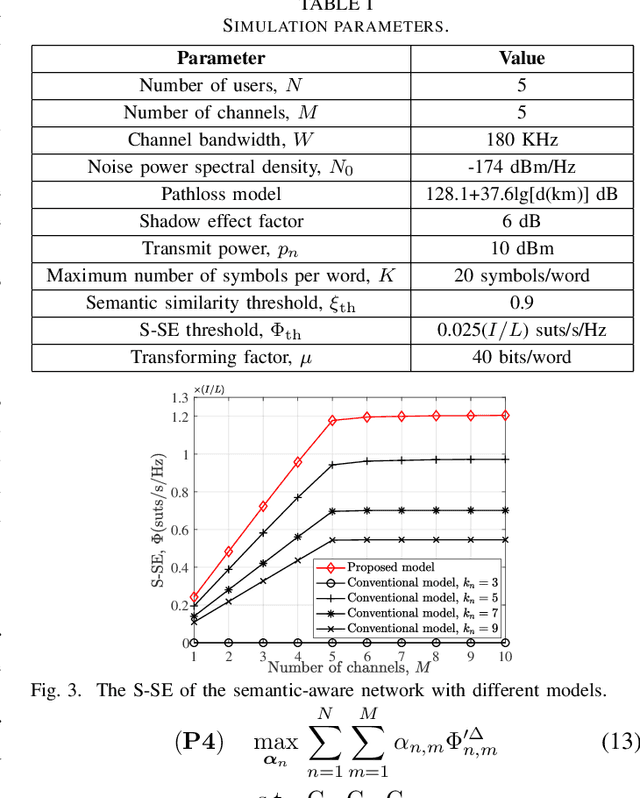
Abstract:Semantic communications have shown its great potential to improve the transmission reliability, especially in low signal-to-noise regime. However, the resource allocation for semantic-aware networks still remains unexplored, which is a critical issue in guaranteeing the transmission reliability of semantic symbols and the communication efficiency of users. To fill this gap, we investigate the spectral efficiency in the semantic domain and rethink the semantic-aware resource allocation issue. Specifically, the semantic spectral efficiency (S-SE) is defined for the first time, and is used to optimize resource allocation in semantic-aware networks in terms of channel assignment and the number of transmitted semantic symbols. Additionally, for fair comparison of semantic and conventional communication systems, a transform method is developed to convert the conventional bit-based spectral efficiency to the S-SE. Simulation results demonstrate the validity and feasibility of the proposed semantic-aware resource allocation model, as well as the superiority of semantic communications in terms of the S-SE.
 Add to Chrome
Add to Chrome Add to Firefox
Add to Firefox Add to Edge
Add to Edge